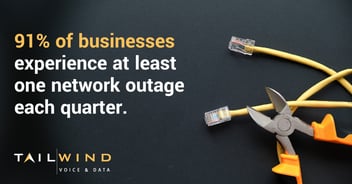Horizontal vs. Backbone Cabling: Compared
Effective cabling infrastructure is a critical component of modern enterprise networks, especially for organizations with multiple locations. A well-designed and optimized cabling system ensures seamless communication, efficient data transmission, and reliable connectivity to support current networking demands and a scalable foundation for future growth.
In this blog, we'll explain the differences between backbone cabling and horizontal cabling and how they contribute to the overall performance of multi-location enterprise networks.
Structured Cabling System Basics
A structured cabling system is a telecommunications infrastructure that provides a standardized architecture for managing and organizing cable installations within a building or across multiple locations. Implementing structured cabling offers enterprises several benefits, including easier maintenance, scalability, and compliance with industry standards.
Structured cabling systems are typically comprised of five subsystems found throughout a building, including:
Equipment Room
The equipment room is a dedicated space that houses the critical equipment responsible for serving the organization's users, such as servers, routers, switches, and other networking hardware. It acts as the central hub for network connectivity and data processing, enabling seamless communication and data exchange throughout the entire infrastructure.
Telecommunications Room
The telecommunications room contains the necessary equipment that connects the backbone cabling and horizontal cabling subsystems. It serves as an intermediate distribution point, facilitating communication between different floors, buildings, or locations within the organization's premises. These rooms play a crucial role in routing and distributing voice, data, and video services to their intended destinations.
Backbone Cabling
Backbone cabling is the system that connects telecommunications rooms and equipment rooms, providing the main route for data transfer between different buildings, floors, and equipment rooms within a building. It forms the high-capacity backbone of the entire structured cabling system, enabling the transmission of large amounts of data over long distances.
Horizontal Cabling
Horizontal cabling is the system that connects the telecommunications room to individual work areas or outlets, delivering data, voice, and video services directly to the end-users. This cabling system is responsible for the final link between the backbone cable infrastructure and the users' workstations, ensuring seamless access to the required telecommunication services.
Work Area Components
Work area components refer to the equipment and cabling that connect end-user equipment, such as computers, phones, and printers, to the horizontal cabling system's outlets. These components provide the final link between the structured cabling system and the end-user's workstation, enabling them to access the necessary resources and services.

What Is Backbone Cabling?
Backbone cabling forms the backbone of a structured cabling system by providing high-capacity interconnections between various telecommunications rooms, equipment rooms, and entrance facilities. Backbone cable typically consists of fiber optic or high-pair-count copper cables, which offer superior bandwidth capabilities and longer transmission distances compared to conventional twisted-pair cables.
The components of a backbone cabling system include the cables themselves, as well as connecting hardware like patch panels, connectors, and cable management systems. Fiber optic cable is often the preferred choice for backbone cabling because it can transmit data over longer distances with minimal signal degradation.
What Is Horizontal Cabling?
A horizontal cabling system extends telecommunication services directly to end-users' work areas. This cabling system connects each telecommunications room to individual work area outlets or devices throughout a building, such as computers, phones, and printers.
Horizontal cable typically includes twisted-pair copper cables (such as Cat5e, Cat6, or Cat6a) or fiber optic cables, patch panels, wall outlets, and patch cords. Industry standards require that individual horizontal cables not exceed 90 meters (295 feet) in length between the work area outlet and each patch panel in the telecommunications room.
How Do Backbone and Horizontal Cabling Differ?
To help you better understand the differences between backbone and horizontal cabling, let's explore their primary characteristics:
Purpose
Backbone cabling carries the bulk of data traffic between the main distribution frame (MDF) and intermediate distribution frames (IDFs), acting as the high-capacity backbone of the entire network infrastructure. For example, in a multi-building campus, the backbone cables would interconnect the telecommunications rooms across different buildings. Horizontal cabling delivers data, voice, and video services directly to the user's work area, providing the final link between the backbone infrastructure and the end-users' workstations.
Location
Backbone cabling is typically run vertically, spanning different floors or buildings within a campus or complex, enabling communication between various telecommunication rooms and equipment rooms across the organization's premises. Horizontal cabling is run horizontally, connecting each telecommunications room to work area outlets within a building or on a floor to ensure end-users have access to the necessary services in their immediate work environment.
Cable Types
Backbone cabling often uses high-capacity cables, such as fiber optic or high-pair-count copper cables, to accommodate large volumes of data traffic and ensure reliable transmission over long distances. Horizontal cabling, however, typically uses twisted-pair copper cables or fiber optic cables, depending on the requirements and performance needs of the individual work areas.
Distance Limitations
Due to the nature of the cables and specialized hardware employed, backbone cabling can span longer distances than horizontal cabling, enabling communication across multiple buildings or floors. Horizontal cabling is limited to a maximum length of 90 meters from the telecommunications rooms to the work area outlet, as per industry standards, to maintain optimal signal quality and data integrity.

Optimize Your Backbone and Horizontal Cabling With TailWind
Having an optimized structured cabling system is crucial for organizations that rely on seamless communication and data transmission across multiple locations. Poorly designed or implemented cabling can lead to performance bottlenecks, increased downtime, and lost productivity.
TailWind delivers structured cabling your enterprise can rely on. Our cabling experts manage all aspects of your network or telecommunications cabling installation project, from design and implementation to ongoing support. We'll provide unbiased advice and end-to-end accountability to complete your project on time and within budget, whether you need to relocate branches, optimize your OSP system, run new applications, or add advanced services.
For organizations with complex networking requirements across multiple sites, proper cabling design and deployment are essential for enabling efficient operations and growth. Ready to build a solid foundation for your network? Reach out to TailWind today for future-proof structured cabling tailored to your organization's specific needs.


